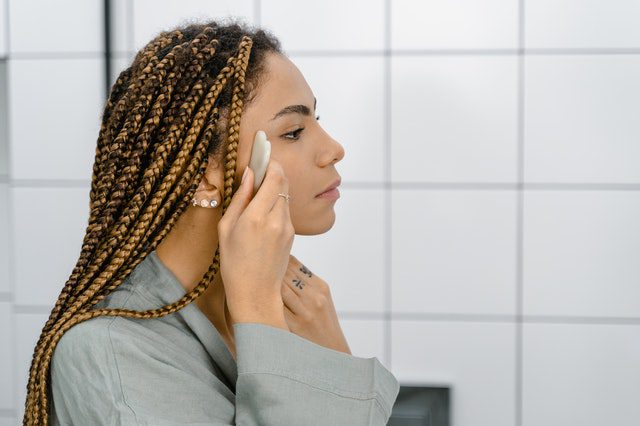
Electrolysis For Face
Electrolysis is a form of permanent hair removal which works directly on the hair follicles. While everyone has fine hair on their faces, and it is considered completely normal, this sort of treatment is usually sought out by trans feminine people who are not getting the desired results from hormone treatments when it comes to facial hair removal.
Electrolysis treatments are an excellent option for permanently removing unwanted hair in this capacity as it tends to be better suited to smaller surface areas, such as the face as opposed to the legs. It is also permanent and is less likely to cause severe side effects than some chemical alternatives that are temporary and use harsh chemicals on the skin repeatedly.
Something that greatly helps the efficiency of electrolysis for trans feminine people is the fact that Estrogen will reduce facial hair a lot already, so removing hair that remains after a year or two on hormones would be relatively easy. It is a fantastic option for permanent hair removal and is suitable for sensitive areas like the face.
It is also effective on all hair types, not only dark hair on fairer skin, as is the case with laser hair removal. Electrolysis is a method of hair removal that is commonly used on eyebrows, upper lip, and even the bikini line.
What is Electrolysis?
Electrolysis is usually defined as a cosmetic procedure used to remove unwanted hair. A thin metal probe is inserted into the hair follicle and delivers a low-level electric current which damages the follicle and therefore stops hair growth. Needle electrolysis leaves no hair behind in the long run.
What makes it so effective at removing hair is that the technician inserts a fine needle into the hair follicles and delivers this electro pulse straight to the source of the hair. Most people experience some pain during the treatment process, but many clinicians will provide a numbing cream that reduces pain levels drastically. Your skin may also show some redness and swelling following treatment, but this ordinarily clears up quickly.
Electrolysis is time-consuming and involves several treatments lasting 15 minutes to an hour per session and can take up to 30 sessions spaced a month apart before all the unwanted hair is gone.
This method of hair removal is safe for sensitive areas. It does cause some discomfort or pain due to the nature of the treatment. Some places will provide a numbing cream during treatment in order to make you more comfortable. Following electrolysis treatment, you may notice some re-growth. It is important that you not pluck these hairs but rather trim them so that the hair growth cycle is not disrupted.
Laser Hair Removal vs. Electrolysis
The main difference between laser hair removal and electrolysis is that laser generally only works on fair skin with darker hair. Red, blond, or light brown hair, or people with dark skin, will not see the results they are looking for in hair removal treatments.
Alternatively, electrolysis tends to be more painful than other hair removal procedures, despite being more appropriate for all skin and hair types. It takes longer to permanently remove hair, and in order to allow complete healing on and below the skin’s surface, your next treatment will only take place once your body has healed and all redness/swelling is gone.

Skin Care After Electrolysis Session
The most important part of your aftercare will be to keep the treated skin completely clean. You will also need to keep the treated area completely dry. This will need to last for at least two days after treatment. The electrolysis process can be time-consuming, and it is important that you keep up aftercare so that you can reduce redness and the chance of scarring.
You will need to help your body heal after each electrolysis treatment. Remember, this is only a permanent method if it is completed over quite some time.
Temporary Side Effects
There are some general side effects that are very common following treatment. Things like redness, swelling, and skin sensitivity are common symptoms on treated areas for the first two days (48 hours) following treatment. The treated areas can also feel hot for the first 48 hours (two days) after treatment. Ordinarily, though, this clears up within a few hours.
Less common side effects of electrolysis include crusting or pin size scabbing along with tiny bruises to form on the treated areas. There might also be some itching when the healing process gets going.
Some people experience dry skin from hair electrolysis, and it is advised to maintain regular applications of an Aloe Vera type gel for around 21 days following treatment. It is important for you to discuss the risks and benefits of hair removal options during your initial free consultation with a clinician.
Some places regulate electrolysis and laser hair removal, and it is important that you know these regulations.
Preventative Steps
It is important that you not pick at any scabs. Picking will increase scarring and chances of infection. Your skin can take anything from 7 to 21 days to fully heal. After treatment, you should avoid touching the area, even if you notice hair growth here. Some facial or body hair will return initially and will require a few more sessions to get rid of completely.
Following hair electrolysis, you should avoid tanning lotions, tanning beds, and perfumes, including perfumed body lotions; as with tattoos or other skin treatments, you should keep away from direct sunlight.
Sunscreen with a high SPF should be applied liberally and often. Even if you have darker skin types. Redness is not the biggest problem here. Exposure to these things following soon after electrolysis can lead to hyperpigmentation.
Furthermore, you should stay away from saunas, steam chambers, jacuzzis, and solaria following electrolysis. These things can also cause hyperpigmentation. Unfortunately, hot showers and baths should also be avoided, along awith swimming (submerging the area for long periods). You will not be able to put on makeup either.
You will need to use a special soap to clean the area and should not be using store-bought varieties. Anything that stimulates blood flow after your treatment should be avoided, such as exercise.
If you find that you have more ingrown hair after treatment, you can use a gentle exfoliant to help get rid of these ingrown hairs in the short term until electrolysis can get rid of them permanently.
Serious Side Effects
While some skin irritation is completely normal during the healing process, there are some side effects that are more serious and can be permanent. Sun exposure or plucking of returning hairs can cause changes to skin color called hyperpigmentation.
If your skin is very sensitive or reacts violently, then excessive swelling can occur shortly after the electrolysis process. In rare cases, permanent scarring or other permanent skin damage can occur, although these cases are rare. Finding a good electrologist and following aftercare steps carefully can greatly diminish the risks of serious side effects.
Infection can also end in scarring on the affected area, which is another reason to avoid plucking re-growing hairs. This opens your skin up to risks of infection.



